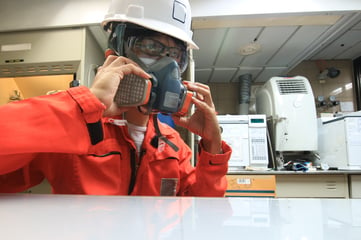
Do I really need a respirator program?
If you are ok with having a team of workers carrying around oxygen tanks and piles of medical bills, fines and lawsuits landing on your desk, do what makes sense to you. If you have a lick of sense, you may want to refer to OSHA and NIOSH for the requirements and permissible exposure limits (PEL) you need to meet to stay in business.
OSHA standard 29 CFR 1910.134 and 1926.103 says you must provide a respirator if your employees must work in environments that include:
- Insufficient oxygen
- Harmful dusts
- Fogs
- Smokes
- Mists
- Fumes
- Gases
- Vapors
- Sprays
- Silica
Respirators are the Last Line of Defense
Employers must make every attempt to put engineering controls in place or replace toxic materials with safer ones. If you can’t eliminate the dangers, then respirators and respirator cartridges must be properly selected and provided to workers. Don’t think you can just pass them out with a quick intro about them and then wash your hands of it. Workers need regular training, fit testing, medical evaluations and instructions on usage, cleaning, maintenance and repair.
So, what’s the science behind cartridges?
Here’s how they work:
When you inhale, air flows in through an inlet on the respirator, through the filter to remove any dangerous substances from the air around you. Depending on the kind of contaminant, the dangerous substance can be removed through particle filtration, chemical absorption or adsorption or by using a chemical reaction to neutralize a chemical. Teams of scientists and experts created filters and cartridges that protect against specific contaminants. So, don’t go thinking you can swap out a white acid gas cartridge for a purple particulate one.
Check out this handy color chart from OSHA that can help with choosing your next respirator cartridge
%20Design%20Cartridge%20Color%20Code%20Chart.jpg?width=600&name=Quad%20City%20Safety%20(Respirator%20Protection)%20Design%20Cartridge%20Color%20Code%20Chart.jpg)
Here are a few steps to make sure your respirator stays in good shape:
- Remove filters and cartridges: Make sure you don’t miss this step or you may as well toss your equipment out. Cartridges can’t be cleaned; they can be reused if appropriate or replaced, but never cleaned
- Don’t clean with solvents: Use a mild detergent with disinfectant & warm water, rinse and air dry. Respirators require cleaning. You can use disposable wipes for in-between uses; just make sure they don’t contain alcohol
- Store away from dust, sunlight, heat, extreme cold, moisture, chemicals or exhaust fumes: When not using the respirator, make sure you remove cartridge and store in a sealed bag. They can’t just be tossed in a tool box or the cab of a truck. They should always be kept clean and dry. Extend the life of the cartridge by keeping it away from any contaminated areas
- Change out schedule: Change your cartridges according to manufacturer’s instructions. Have a change out schedule in place based on the contaminants you are working with, the concentration, frequency and length of use, the temperature and humidity of the workplace and any chemicals that could interfere with the life of cartridge
- Inspect, record and test: It’s important to inspect your equipment and make sure everything is in working order and free from damage. Some things to inspect include face piece, head straps, valves, cartridges, hoses diaphragms, batteries, supplied air hoses and quick connects. Keep track of inspections and medical evaluations, fit tests and test equipment regularly
Take a deep breath, in and out. Feels good right? Well, keep that good feeling by taking respiratory health seriously, for yourself and your crew. Start by assessing all the hazards that are on the job. Eliminate what you can, and protect against what you can’t. There is a science behind the respiratory protection you offer your workers. Don’t try to cut corners by providing the wrong respirator cartridge.
If you need help on choosing a respirator cartridge and saving money, just ask. Look for the HELP ME button on our website or right here!
Have we helped to make the science behind cartridge selection a little easier to understand? Let us know your thoughts in the comments below!
Safety: It’s Your Life, It’s Our Business








